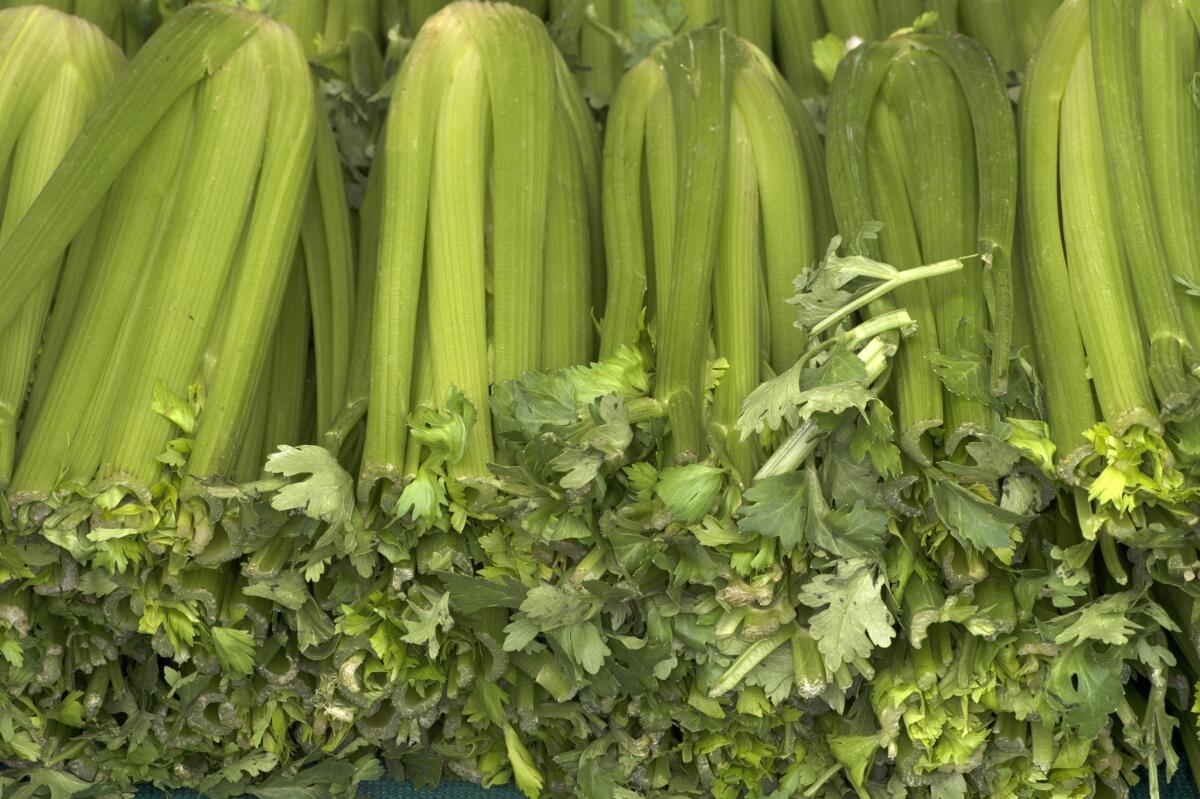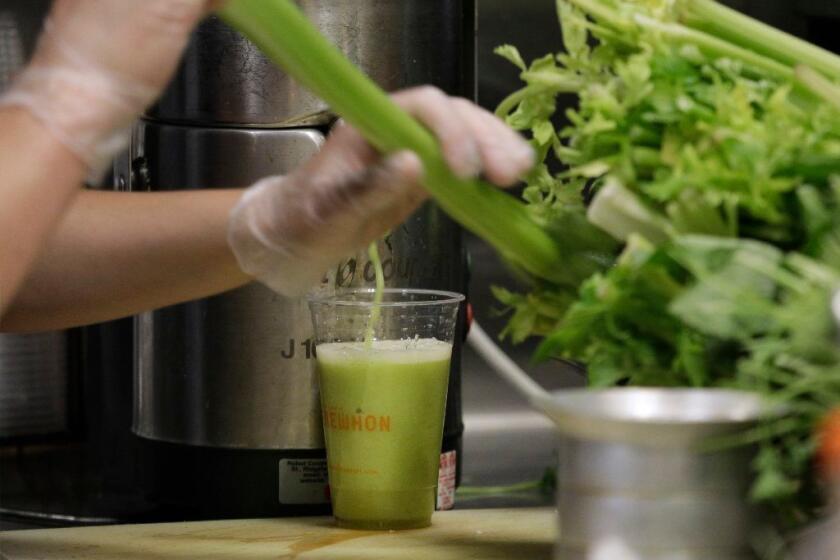Growing your own celery is easier than you think

- Share via
Who knew that celery, the last item left on every veggie plate, would become a wellness star? Yes, we’re talking about the same lowly vegetable whose wholesale price has soared as juicers clamor to buy the slender stalks (and the rest of us smear them with peanut butter to make them appealing).
“Medical Medium” Anthony William may extol the benefits of drinking 16 ounces of celery juice a day (based on advice from a spirit voice), but home cooks have long relied on the vegetable to add oomph to soups, stews and other savory dishes.
Suddenly, celery’s all the rage.
But for some reason, celery is not a winter garden staple like other greens, and that’s a shame, says Gardening in L.A. blogger and master gardener Yvonne Savio. “If you’re a cook, you need to grow celery, because you get twice as much as what you buy at the store.”
That’s because most grocery store celery is trimmed so that only the pale, sweeter stalks remain. Celery grown in the garden has longer stalks ending in beautiful leafy tops that can be juiced or diced and added to soups and stews.
The plant prefers cooler weather, rich and fertile soil and ample water to grow crisp and juicy, so winter is a perfect planting time in Southern California. Here are Savio’s tips for growing enough leafy stalks to keep your stews — or your juicer — well supplied:
On a recent Saturday afternoon, shoppers at Erewhon Market on Beverly Boulevard made a beeline to the produce aisle to stock up on bundles of organic celery.
How to start?
Savio recommends starting with celery seedlings; she says a six-pack is more than enough for a family. It takes only one large stalk to create 16 ounces of juice, or a few diced stalks to complement a stew, so unless you’re juicing for the entire family (or raising rabbits), you might want to share your six-pack of seedlings with a friend. If your local nursery doesn’t have celery seedlings in stock, most will order them. Call ahead and ask.
Soil or pot?
You can plant the seedlings in the ground or in a large pot, Savio said. Celery roots range from 18 to 24 inches, according to a vegetable root depth guide prepared by the University of California Cooperative Extension for Los Angeles County, so look for a pot that’s as deep as possible, Savio said. “For any vegetable, find the optimum depth and then add another 4 inches to the pot so the roots have some room to grow. You don’t want them pushing against the sides of the pot.” Finally, choose a sunny location; celery can’t handle high summer temperatures, but during the winter, when days are shorter and the sun less intense, they need at least four to six hours of sun daily.
Soil matters
Like most vegetables, celery needs fertile, well-amended soil to thrive. Savio recommends spreading 1 to 2 inches each of compost and cow or steer manure, topped with an inch or so coffee grounds — her personal secret sauce for mulching and enriching her garden soil. You don’t need to dig the amendments into the soil as much as scratch them in a few inches deep, she said, but do let them “cook” for a week or so; fresh amendments, especially manures, initially raise the soil temperature and can burn tender seedling roots. Prepare your soil first and let it cook while you shop for your celery starts (and other winter vegetables.) If you’re using a pot, Savio recommends mixing two-thirds good potting soil with one-third equal mixture of compost and manure, topped with a cup or two of coffee grounds. (Savio collects her grounds from coffee shops.)
Water = crispness
Celery needs water to grow straight, sweet and tall, Savio said, so keep the soil moist. A rainy winter can provide all the moisture necessary, but if your celery starts tasting “like turpentine” or the stalks get soft and “feel a little wobbly,” those are signs more water is needed. If there’s no rain, Savio waters her well-amended Pasadena garden deeply just once a week in the winter, but her soil holds water well. Your garden might need more frequent watering. You can use the finger test (stick your finger 3 inches into the soil and if it feels dry, water) or buy a three-way soil meter that measures soil moisture for about $10. Once the weather starts getting hot, your celery will start producing seeds and turn bitter, much the way that lettuce bolts in the heat.
Harvest from the outside
The celery in your garden is going to be taller, bushier and a deeper green than the pale stalks you usually see in the supermarket, because retail plants have been trimmed of their outer branches. The inner branches have a lighter color and milder taste because they’re hidden from the sun, Savio said. You can blanch your celery by tying the growing plants into little bundles or cutting the top and bottom off a half-gallon milk carton and placing it over the top of your newly planted seedling. That will keep the sun off the stalks as the plants grow. The deeper green stalks have a stronger flavor, Savio said, which is great for cooking but may be more intense as juice. Once your plant has eight to 10 good-size stalks — usually within four to six weeks — you can start harvesting, she said. Snap off stalks at the base, from the outside. Cutting stalks can open a wound in the plant and weaken it, Savio said. The plant will grow new stalks until it goes to seed, so expect to keep harvesting celery well into the spring. And if you let your plant go to seed, expect a final beautiful display of delicate white flowers.
On a recent Saturday afternoon, shoppers at Erewhon Market on Beverly Boulevard made a beeline to the produce aisle to stock up on bundles of organic celery.
More to Read
Sign up for The Wild
We’ll help you find the best places to hike, bike and run, as well as the perfect silent spots for meditation and yoga.
You may occasionally receive promotional content from the Los Angeles Times.











